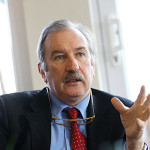Investment Plan for Europe
 Europe’s economy is recovering but investment remains at mid-recession levels. Peter Cheney summarises the European Commission’s plans to boost infrastructure spending.
Europe’s economy is recovering but investment remains at mid-recession levels. Peter Cheney summarises the European Commission’s plans to boost infrastructure spending.
The Investment Plan for Europe promises to release €315 billion for infrastructure by 2017, thus helping to deliver capital projects which would otherwise be considered too risky to fund.
Legislation to set up the European Fund for Strategic Investments (EFSI) – to implement the plan – is currently being considered by the European Parliament. The fund will be overseen by Competitiveness Commissioner Jyrki Katainen and will also involve the European Investment Bank (EIB). Katainen has explained that it “will support projects with a higher risk profile so that investment starts taking off in countries and sectors where job creation and growth are most needed.” He is currently visiting member states to persuade governments to contribute to the scheme.
“Now is the moment for Europe to recover its nerve and make the long-term changes that we need to secure our common future,” he told business leaders in Belgium. Katainen also emphasised the Commission’s openness to learning from the private sector: “As public officials we tend to regulate the past. We need feedback from the private sector on how best to regulate the future.” The EU’s GDP has returned to its 2007 peak but the level of investment is still 15 per cent below that level: down from €3 trillion to €2.6 trillion. The drop is deeper in Ireland: 40 per cent.
Most of this decrease took place immediately after the 2008 financial crisis. A slight recovery occurred in 2011 when investment rose to around €2.7 trillion but the trend has been downward since then. By comparison, the last recession was followed by a significant recovery in investment: up by 10 per cent between 1993 and 1997.
As well as slowing down the recovery, a shortage of investment holds back growth, productivity and job creation in the longer term. Low investor confidence is the primary reason for the shortfall.
While leftist parties are demanding more investment from EU funds, the Commission maintains that this is not politically possible and the existing budget should instead be used as a catalyst for private investment. This year’s budget totals €162 billion and around €77 billion is geared towards economic growth i.e. the competitiveness and cohesion funds. Increased liquidity in financial institutions and large corporates should also be used to deliver for Europe’s citizens.
Fourteen new Irish primary care centres will be funded through the plan. According to Commission estimates, it may add up to €410 billion to EU GDP and create up to 1.3 million new jobs by 2017. Economist Michael Smyth, the European Economic and Social Committee (EESC)’s rapporteur for the plan, emphasises that it is well on track. “The EIB’s already raised the money,” he tells eolas. “They’ve already used the €21 billion to sell AAA bonds on the market. They will raise €63 billion on the strength of that.”
Quantitative easing by the European Central Bank – while not connected to the plan – will have the effect of keeping interest rates very low thus making it easier for the EFSI to operate. Smyth points out that four proposed energy interconnectors either across Ireland and between Britain and Ireland were “deemed as fundable” by the Commission: “Obviously if consumers are paying their gas and electricity bills, the operators will be able to go to the pension funds and markets to get the money.” Other potential projects could include a rail link to Dublin Airport and the proposed financial services hub at the Port of Dublin.
A properly working technical advisory hub will be “absolutely crucial.” Many projects cannot get funding at present because of the financial risks involved but the Investment Plan could help to get them on the ground.

Structures
The EFSI will be held within the EIB and will be accessible to member state governments, national banks, public sector agencies and private sector investors. Participation by countries and organisations based outside EU will be subject to the consent of existing contributors. This may become a live issue for cross-border projects between the UK and Ireland if Britain votes to leave the EU. A guarantee fund – financed via the EU budget – will stand at €1.4 billion in 2015 and is expected to reach €8 billion over time. The doubling of the guarantee brings it up to the €16 billion i.e. the European Commission’s initial contribution to the EFSI. Another
€5 billion will be contributed by the EIB, thus bringing the capital to €21 billion.
Contributions by member states to the EFSI will not be counted when assessing the fiscal adjustment under the Stability and Growth Pact. A steering board will decide the overall orientation, investment guidelines, risk profile, strategic policies and asset allocation of the fund, with the number of board members and their voting strengths based on the size of the participants’ contributions.
Decisions will be initially taken by consensus between the EIB and Commission. When other contributors join the fund, decisions will be taken by either consensus or simple majority (if no consensus can be found) with the EIB and Commission having the power of veto.
The investment committee, accountable to the steering board, will vet specific projects (without geographic or sectorial quotas). The advisory hub will be based at the EIB and will help to identify, prepare and develop projects across the EU.
Financing
The EFSI will, as explained, start with €21 billion from the Commission and EIB with the potential, as mentioned, for other public and private sources of investment to follow. The Commission plans to source its contribution from the Connecting Europe Facility (for digital and broadband projects) and the Horizon 2020 R&D programme.
Reaching the goal of €315 billion will require a 1:15 multiplier effect, predicted as follows:
• every €1 from the fund should provide €3 for a project through sub-ordinated debt;
• every €1 of sub-ordinated debt should generate another €4 in senior debt from private investors;
• the total estimated yield is therefore €12 from senior debt and €3 from sub-ordinated debt.
The Commission views the multiplier effect as a “prudent average” based on historical experience from the EIB and previous EU programmes. It wants to see a shift from grants to loans, equity and guarantees. Member states and regions will be asked to increase the amount of co-financing above the minimum legal requirements.
The Juncker Commission’s political guidelines (effectively its manifesto for Europe) prioritise projects in the following areas:
• digital infrastructure;
• energy;
• transport;
• education;
• research and innovation;
• job creation; and
• environmental sustainability.
Projects which can start within the next three years are preferred. Not all projects in the pipeline should (or will) be financed by the Investment Plan but publishing as much detail as possible will highlight the potential for investment and improve confidence.
The advisory hub will host a portal through which project promoters, investors and managing authorities can source technical assistance.
The European Economic and Social Committee welcomes the change in tone away from austerity and fiscal consolidation. It warns that the EIB may have to rely on commercial banks (who may prefer their favoured clients) and suggests giving economic development agencies and business associations a greater role in identifying potential recipients.
Meanwhile, the European Parliament has objected to plans to ‘feed’ the EFSI from existing research and transport investment budgets. Its report adds that eligibility for projects should be restricted to those which are economically viable, reflect EU priorities, ineligible for EU budget or EIB finance, and have a higher risk profile than those that could be financed by the bank.
The final details of the Investment Plan are now being agreed and all indications point to it ‘going live’ next month.





